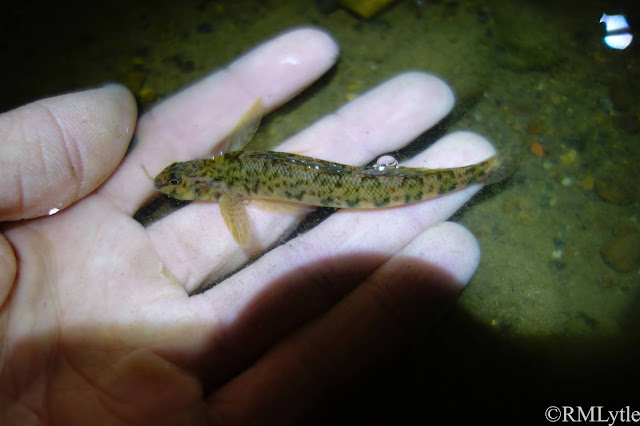Our plan was to use our lights to sight fish for small fish species that become somewhat more active after dark, as well as those that are easier to single out that way. Hunched over, searching the shallows, we soon began to find fish we'd not caught before. Jake spotted one first, a small longhead darter. We ended up spooking that fish. Then Noah spotted a stonecat; a species of madtom, small catfishes of the Noturus genus. We tried to get that particular individual for a while without success, but soon found more. Jake got one before Noah or I. It was the first lifer of the trip for him, and in my opinion the most interesting of the ones caught already between the three of us.
I struck next with a stonecat of my own. It was definitely hard to get them to eat a fly, but I was able to deceive one, or rather bother one into snapping at a tiny nymph. This was my 4th new species of the trip and my first madtom of any species. It was also my 8th catfish species on the fly.
 |
| Lifelist fish #169. Stonecat madtom, Noturus flavus. Rank: Species. |
Then I found a darter. I'd put my tanago midge in front of many already this night but none were at all interested. Most were quite scared of it, actually. But this one ate. I knew that whatever it was, it was a new species. This individual turned out to be a greenside darter.
 |
| Lifelist fish #170. Greenside darter, Etheostoma blennioides. Rank: species |
When we got to some faster water, the small black water beetles I've always know as whirligigs became a giant pain, swarming our light and making it impossible to spot fish. So we started to work our way back down. On the way up, Jake had noted a slack, muddy, weedy spot and drew correlation between it and where we'd spotted the first longhead darter. Sure enough, he found one there and then caught it, his second lifer of the night.
 |
| Longhead darter, Percina macrocephala |
By then our spines were destroyed, it was getting quite chilly, and we'd fished quite a lot of water and caught a bunch of very cool fish, so we decided to go find a spot to sleep in the cars. We found a good spot, said goodnight, and went to sleep wondering what the next day might bring.
Until next time,
Fish for the love of fish.
Fish for the love of places fish live.
Fish for you.
And stay safe and healthy.
Fish for the love of places fish live.
Fish for you.
And stay safe and healthy.
Thank you to my Patrons; Erin, David, John, Elizabeth, Brandon, Christopher, Shawn, Mike, Sara, Leo, and Franky for supporting this blog on Patreon.





Nice catches from Northern PA waters. Put Muskies on the menu next time.
ReplyDeleteTie, fish, write, conserve and photo on...
Muskies are more inclined to take themselves off the menu than I am.
DeleteWas an absolute pleasure to be there!
ReplyDeleteMan it was fun. Can't wait for the next trip.
Delete